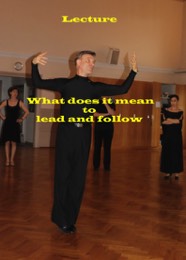Workshop Lecture
I am happy to offer my new lecture/Lerhgang modules to the dance schools, clubs, Swissdance members.
Each module lasts 1.20 minutes.
The information within the module will be useful to all levels of dancers that wish to have a deeper understanding of how dancing really works.
Each module lasts 1.20 minutes.
The information within the module will be useful to all levels of dancers that wish to have a deeper understanding of how dancing really works.

Why does lead and follow matter
If you and your partner have already choreographed a set of figures, and if you aren't going to have to dance around other dancers, then you don't need lead and follow. Usually, in social dancing, the lady doesn't have any idea of what the man is going to do next. It will be an awkward dance at best if the man doesn't have a way of communicating what he plans to do on the dance floor. Lead and follow is how the man communicates to his partner what he would like both of you to do. If mans knows how to lead well, and his partner knows how to follow well, the man can lead her through patterns she's never even seen before, and make it look good. If man can lead really well, he can lead someone who doesn't even know how to dance. Sometimes you see such skilled leaders in action.
Connection
Lead and follow cannot happen without a connection between the leader and follower. So, what's a connection? A functional definition would be leader and follower knowing where their partner is, and what their partner is doing, based only on physical contact.
Roles of leader and follower
The leader keeps time, and suggests, through his lead, the figures that will be executed in a dance. That means the leader has the job of maintaining the rhythm, knowing the figures of a dance, and deciding what figures he is going to lead, in addition to actually leading them. The follower, through reading the signals of the lead, executes the suggested figures. Connection is extremely important, because it is through the connection that the lead is communicated.
Leading and Following
The lead comes out of the body. The hold and upper body, is transmitting through the contact of the 2 bodies with connected hands. In practical terms is that your upper arms stay fairly fixed relative to your body. Never stiff or rigid but you could describe it as they can breath.
Having a good connection, the leader and follower will move together around the room. If you don't have a good connection, the leader will have different speeds and often disturbing the partners balance.
If the man would have the correct tension in his arms, and the appropriate position of his arms relative to his body, and if his partner does the same, when the man moves his body, this leads his partner to move her body.
If you and your partner have already choreographed a set of figures, and if you aren't going to have to dance around other dancers, then you don't need lead and follow. Usually, in social dancing, the lady doesn't have any idea of what the man is going to do next. It will be an awkward dance at best if the man doesn't have a way of communicating what he plans to do on the dance floor. Lead and follow is how the man communicates to his partner what he would like both of you to do. If mans knows how to lead well, and his partner knows how to follow well, the man can lead her through patterns she's never even seen before, and make it look good. If man can lead really well, he can lead someone who doesn't even know how to dance. Sometimes you see such skilled leaders in action.
Connection
Lead and follow cannot happen without a connection between the leader and follower. So, what's a connection? A functional definition would be leader and follower knowing where their partner is, and what their partner is doing, based only on physical contact.
Roles of leader and follower
The leader keeps time, and suggests, through his lead, the figures that will be executed in a dance. That means the leader has the job of maintaining the rhythm, knowing the figures of a dance, and deciding what figures he is going to lead, in addition to actually leading them. The follower, through reading the signals of the lead, executes the suggested figures. Connection is extremely important, because it is through the connection that the lead is communicated.
Leading and Following
The lead comes out of the body. The hold and upper body, is transmitting through the contact of the 2 bodies with connected hands. In practical terms is that your upper arms stay fairly fixed relative to your body. Never stiff or rigid but you could describe it as they can breath.
Having a good connection, the leader and follower will move together around the room. If you don't have a good connection, the leader will have different speeds and often disturbing the partners balance.
If the man would have the correct tension in his arms, and the appropriate position of his arms relative to his body, and if his partner does the same, when the man moves his body, this leads his partner to move her body.